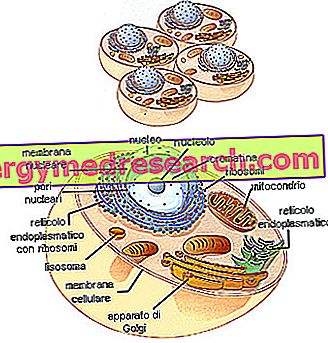Generality
Pain in the right side is a symptom that can distinguish different conditions, some clinically more important than others.

As for the triggering causes, these range from simple traumas involving the muscles to morbid conditions of a certain clinical relevance, such as gallstones, appendicitis, duodenal ulcer, kidney stones, ectopic pregnancy, the disease of Crohns etc.
Identifying the exact origin of a pain in the right side is essential for planning a correct therapy.
What is pain on the right side?
Pain in the right side is a symptom that can characterize many conditions, some decidedly more serious than others.
The term right side identifies an anatomical area of a certain extension, in which different organs, muscles and nervous structures reside.
Anatomically, the right side can be divided into two sections: the right side located in the upper part of the abdomen (upper right side) and the right side located in the lower part of the abdomen (lower right side).
SUPERIOR RIGHT SIDE BODIES
The organs of the right side, located in the upper part of the abdomen, are:
- The liver;
- The gall bladder (or gallbladder) and bile ducts;
- The duodenum, or the first part of the small intestine (the other parts are the jejunum and the ileum);
- The so-called "head" of the pancreas;
- The upper part of the right kidney;
- The right adrenal gland;
- The so-called hepatic colonic flexure, or the folding of the colon between the ascending and the transverse tract (NB: through the figure below, the reader can review the anatomical sections of the large intestine).

It is recalled that the so-called intercostal nerves run between the coasts. Originating in the spinal cord, the intercostal nerves are peripheral nerves (that is, belonging to the peripheral nervous system), which innervate the muscles of the thoracic cage, the skin that covers the thorax and the internal tissues of the thoracic cavity.
BODIES OF THE LOWER RIGHT SIDE
The organs of the right side, located in the lower part of the abdomen, are:
- The cecum, or the first section of the large intestine (or large intestine);
- The vermiform appendix, that is the tubular formation that departs from the caecum and is located near the outlet of the ileum;
- The ascending colon;
- The right ovary and the right Fallopian tube, exclusively in female subjects;
- The right ureter.
Similar to the case of the upper right side, the covering that covers and protects these anatomical structures includes skin, muscles (the abdominal muscles) and bones (left iliac crest).
Causes
Clearly, the pain in the right side of the abdomen has different causes than the pain in the right side of the abdomen.
In the next two sub-chapters, readers will be able to specifically evaluate what these causes are.
CAUSES OF PAIN AT THE RIGHT UPPER RIGHT
Among the main conditions that can induce the appearance of pain in the right side in the upper part of the abdomen, are:
- Gallstones : also known as gallbladder stones, they are small solid aggregates, made up of cholesterol and calcium salts, and represent one of the most common biliary pathologies.
Their presence is often associated with: abscesses, gallbladder inflammation, chronic diseases of the gall bladder, gallbladder polyps, gallbladder cancer or biliary tract cancer.
Gallstones are responsible for a strong painful sensation when they obstruct the biliary outflow; in such situations, they determine the establishment of a condition known as acute cholecystitis.
The resulting pain can be dull and persistent or acute and in waves; moreover, it can sometimes spread to the back.
Other symptoms: nausea, vomiting, profuse sweating, jaundice, pale stools etc.
- Duodenal ulcer : it is a lesion of the mucosa that internally covers the initial tract of the small intestine, ie the aforementioned duodenum.
This lesion is comparable to a crater-shaped erosion, whose depth varies from patient to patient.
In general, the presence of a duodenal ulcer is linked to the excessive production of acid juices from the stomach or to Helicobacter pylori infection .
The pain induced by the duodenal ulcer tends to be burning, dull and continuous; tends to appear on an empty stomach (ie before or after meals) and during night rest.
Other symptoms: loss of appetite, abdominal bloating, nausea, vomiting etc.
- Belly air : with this terminology, doctors indicate the presence of gas in the stomach. It is among the most common causes of pain in the right side with localization in the upper abdomen.
Generally, the resulting painful sensation is in the form of cramps.
Other symptoms: belching, flatulence etc.
- Kidney stones (with involvement of the right kidney): kidney stones are small aggregates of mineral salts, with formation sites within the urinary tract, particularly in the kidneys. Often linked to an incongruous diet, they can be both asymptomatic and symptomatic.
When kidney stones are symptomatic, the resulting pain can be very acute, sometimes intolerable. Curiously, the change of position can alleviate the painful sensation.
Other symptoms: vomiting, colic, dysuria, anuria, nausea, blood in the urine etc.
- Pyelonephritis : is the inflammation of the renal pelvis (or pelvis). Existing both in acute and in chronic form, pyelonephritis has a bacterial origin.
The resulting pain very often tends to radiate also towards the back.
Other symptoms: fever, feeling sick, vomiting, haematuria, dysuria, etc.
- Pneumonia : it is the inflammation of the lungs, fundamental elements of the respiratory system.
The resulting pain can be acute or can lead to a sense of crushing.
Other symptoms: fever, cough, chest pain, phlegm etc.
- Food poisoning : it is a condition that arises after ingestion of food contaminated with toxins or spoiled.
The resulting pain is very intense and usually appears 48 hours after the consumption of toxic foods.
Other symptoms: vomiting and fever.
- Musculoskeletal trauma, involving the intercostal muscles and / or the ribs : trauma to the intercostal muscles can cause strains or muscle tears; instead, trauma to the ribs can be responsible for fractures.
The pain that can result from the aforementioned injuries can also be very intense, to the point that the person concerned may have difficulty breathing.
Other symptoms: pain during breathing, pain during torsion of the bust, pain on sneezing occasions etc:
- Neuralgia affecting the intercostal nerves (or intercostal neuralgia) : it is a fairly rare morbid condition, which occurs due to damage or malfunction of the intercostal nerves.
The painful sensation that characterizes intercostal neuralgia can be acute and episodic, or dull and constant.
Furthermore, it tends to be diffuse, that is it affects different parts of the rib cage (not only the right district).
Other symptoms: pain during breathing, pain during torsion of the bust, pain on sneezing occasions etc:
CAUSES OF PAIN ON THE LOWER RIGHT SIDE
The conditions that can cause pain in the right side of the lower abdomen include:
- Appendicitis : is the inflammation of the vermiform appendix. Generally, it derives from an internal obstruction of the vermiform appendix, due to the stagnation of undigested material (solidified fecal material, foreign body, etc.) or to the hypertrophy of the appendicular lymphatic follicles (whose dimensional increase very often depends on systemic infections or local).
Usually, appendicitis affects the young population, between 10 and 30 years.
Other symptoms: general malaise, mild fever, abdominal pain in the navel, vomiting, diarrhea, etc.
- Ectopic pregnancy : it is the term that doctors use to indicate a pregnancy that takes place outside the uterus (extrauterine ectopic pregnancy) or in an inadequate location of the uterus (intrauterine ectopic pregnancy). Generally, it is the most common cause of pain in the right flank in pregnant women.
The resulting painful sensation can be acute or dull.
Other symptoms: vaginal bleeding, feeling of dizziness, pelvic pain, nausea, fainting etc.
- Ovarian cyst : it is a small sac full of liquid, which forms inside or on the outer surface of the ovaries.
The resulting pain may be moderate or intense; in general, it is located in correspondence of the ovary (in the specific case, the right ovary), but it can also spread along the leg (obviously right).
Other symptoms: pelvic pain, pain during sexual intercourse, need to urinate often, dizziness, changes in the normal menstrual cycle, etc.
- Constipation : it is the medical term used to indicate a condition in which the faecal emission is scarce and / or infrequent.
Other symptoms: hard / ribbon-like / dark stools, abdominal bloating, perception of abdominal obstruction, etc.
- Intestinal obstruction : we speak of intestinal obstruction when a section of the intestine has a blockage / obstruction, which prevents the normal progression of food along the digestive tract.
Intestinal obstruction should be considered a medical emergency, as it can lead to lethal complications.
The resulting pain is in the form of cramps or similar to a vice.
Other symptoms: dehydration, abdominal distention, abdominal bloating, meteorism, constipation, vomiting, fever, etc.
- Irritable bowel syndrome : it is a chronic disorder of the colon, of a non-inflammatory nature, which alters intestinal motility.
The resulting pain is generally in the form of cramps.
Other symptoms: diarrhea, abdominal bloating, alterations in the chest, etc.
- Crohn's disease : it is a type of inflammatory bowel disease and has an autoimmune origin, that is, it arises from a malfunction of the immune system.
Crohn's disease can affect various parts of the colon.
The resulting pain is generally chronic.
Other symptoms: diarrhea, abdominal cramps, abdominal bloating, anorexia, asthenia, anal pain, dehydration etc.
- Ulcerative colitis : it is another type of inflammatory bowel disease, the causes of which are currently unknown.
In addition to the various sections of the colon, it can also affect the rectum.
As a rule, it affects exclusively the superficial layers of the internal intestinal walls.
Other symptoms: diarrhea, abdominal cramps, abdominal bloating, malaise, blood in stools, night sweats, etc.
- Abdominal hernia : is the outflow / protrusion of a viscus (or an adjacent tissue), which normally resides in the abdominal cavity. Generally, an abdominal hernia appears following a weakening of the muscular wall that covers and contains the organs of the abdomen.
Other symptoms: abdominal bloating, constipation, vomiting, abdominal cramps etc.
- Abscess of the psoas muscle : the psoas is a muscle that originates from the thoracic and lumbar vertebrae and is inserted at the level of the femur. Helps to flex the thigh.
Other symptoms: lack of appetite, weight loss, abdominal bloating, night sweats etc.
- Hematoma of the rectus abdominis muscle : it can appear due to the rupture of an epigastric artery or due to a muscle tear of the rectus muscle.
Generally, the resulting pain begins suddenly and is very acute.
Other symptoms: abdominal mass formation, fever, flushing, pallor, confusion, etc.
Diagnosis
In general, the diagnostic procedure that leads to the identification of the causes of a pain in the right side starts with an accurate physical examination and a careful medical history. Therefore, depending on the circumstances, it can proceed with: an abdominal ultrasound, a radiograph of the abdomen, blood tests, urine tests, stool tests and / or an endoscopy (colonoscopy, gastroscopy, etc.).
The recognition of the condition at the origin of the pain sensation is fundamental for therapeutic purposes: only by knowing the triggers, can the treating physician prescribe the most appropriate therapy.
Treatment
The treatment of pain in the right side depends on the causes.
For example:
- In the presence of Crohn's disease, ulcerative colitis, irritable bowel syndrome, constipation, appendicitis or mild kidney stones, doctors prescribe specific pharmacological treatments and drastic eating habits to patients (which, in general, are incorrect).
Rarely, conditions such as Crohn's disease or ulcerative colitis require the surgeon's intervention.
To know more:
- Diet and cures for Crohn's disease
- Care / diet and drugs for ulcerative colitis
- Treatments for constipation
- Appendicitis drugs
- In the presence of severe kidney stones, abdominal hernia, ovarian cyst, rectal muscle hematoma, ectopic pregnancy, intestinal obstruction, endometriosis and chronic appendicitis, the planned therapy is surgical.
To know more:
- Endometriosis treatments and surgery
- Ectopic pregnancy therapy
- Treatment of intestinal obstruction
- Surgical treatment of appendicitis
- In the presence of bacterial conditions (such as pneumonia), the treatment consists in the administration of antibiotic drugs.
To know more:
- Medications and treatments for pneumonia
- In the presence of trauma to the ribs or intercostal muscles, the treatment for pain in the right side is mainly based on resting and taking painkillers.



